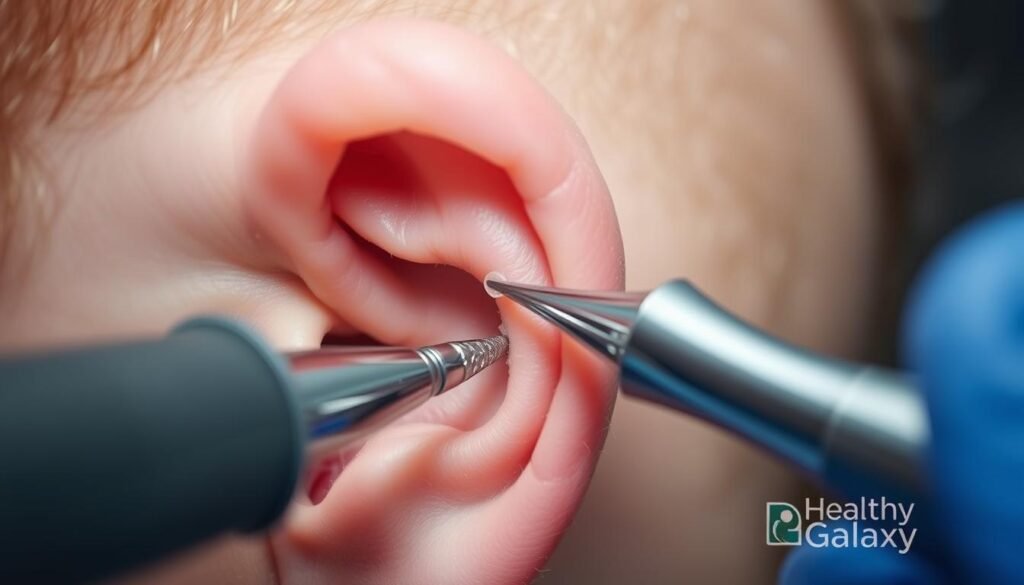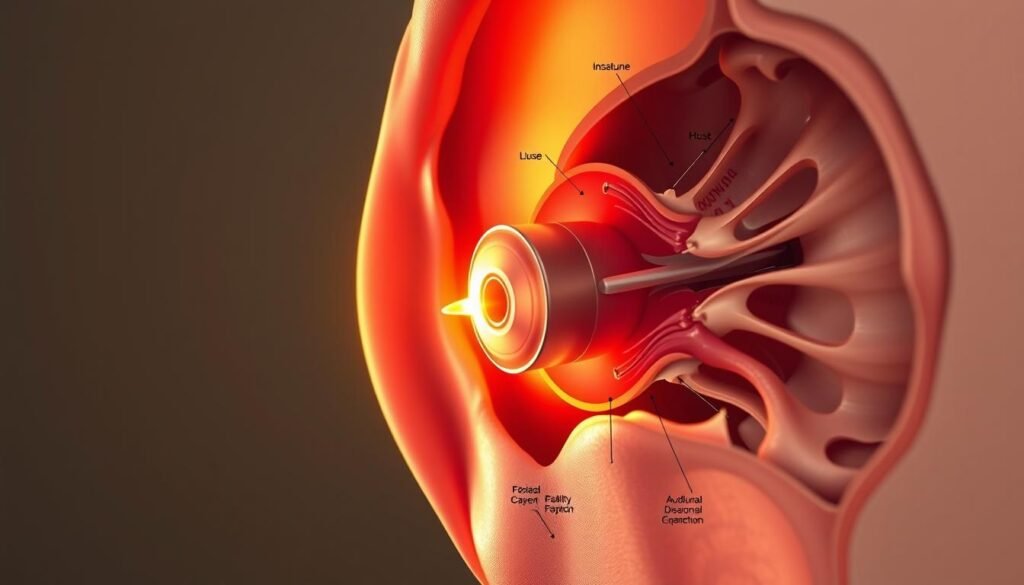The soothing ambiance of a candlelit room, the gentle warmth, and the promise of relief from clogged ears – it’s no wonder ear candling has gained popularity. Proponents claim it not only cleans the ear canal but also boosts overall well-being.
However, the reality is far from these promises. In fact, this wellness trend may be doing more harm than good. candling far outweigh any perceived benefits.
As we explore the world of ear candling, it’s essential to separate fact from fiction and understand the potential risks involved.
Key Takeaways
- The risks of ear candling may outweigh its benefits.
- Potential complications can arise from its use.
- Understanding the process is crucial to assessing its safety.
- Alternative methods for ear cleaning may be safer.
- Consulting a healthcare professional is advised before trying ear candling.
What Is Ear Candling and Why Is It Trending?
Ear candling, also known as thermal-auricular therapy, is an ancient practice that has seen a modern revival. It involves inserting a hollow candle into the ear canal and lighting it, with proponents claiming it can aid in ear wax removal and promote holistic ear care.

The History and Origins of Ear Candling
Ear candling has its roots in ancient cultures, with evidence of its use found in various traditional practices. The technique was initially used for spiritual and healing purposes, believed to purify the ear and promote overall well-being. Its history is rich and diverse, reflecting the cultural significance of ear candling across different societies.
Recent Popularity on Social Media
The recent surge in ear candling’s popularity can be largely attributed to social media platforms, where videos and testimonials about its benefits have gone viral. Many users share their experiences, claiming that ear candling has helped them with issues like sinus congestion and ear infections, further fueling its trend as a holistic ear care method.
As a result, ear candling has become a topic of interest among those seeking alternative health practices, with many turning to it as a natural solution for ear wax removal and other ear-related issues.
The Science Behind Ear Candling: Separating Fact from Fiction
As ear candling continues to trend, it’s crucial to examine the science supporting or refuting its benefits. Ear candling, promoted as a natural ear cleaning method, has been adopted by many seeking alternative health practices.

Claims vs. Scientific Evidence
Proponents of ear candling make several health claims, but it’s essential to scrutinize these assertions in light of scientific research.
Common Health Claims
Advocates claim that ear candling can remove earwax, improve hearing, and even treat various health conditions. Some also believe it can detoxify the body.
What Research Actually Shows
Studies have shown that ear candling does not effectively remove earwax or improve hearing. In fact, research indicates that it can push earwax deeper into the ear canal, potentially causing harm. The scientific community remains skeptical about its benefits as an ear health treatment.
What Actually Happens During the Procedure
During ear candling, a candle is inserted into the ear canal, and the other end is lit. The supposed mechanism is that the heat generated creates a vacuum that draws out earwax and toxins. However, numerous studies have debunked this theory, showing that the procedure does not produce the claimed effects.
The list of potential risks associated with ear candling includes:
- Pushing earwax further into the ear canal
- Causation of ear injuries, such as burns or blockages
- Potential for temporary or permanent hearing loss
In conclusion, while ear candling may be touted as a natural ear cleaning technique, the scientific evidence supporting its use is lacking. As with any health treatment, it’s crucial to consult with a healthcare professional before undergoing ear candling.
Potential Dangers of Ear Candling
The dangers of ear candling are often overlooked in its trending popularity. Despite its seemingly harmless nature, ear candling poses several significant risks to one’s health, making it a practice that warrants caution and awareness.
Physical Risks and Injuries
Ear candling is associated with various physical risks and injuries, primarily due to the nature of the procedure. The use of an open flame and the insertion of a candle into the ear canal can lead to serious complications.
Burns and Fire Hazards
One of the most immediate risks of ear candling is the potential for burns and fire hazards. The candle’s flame can cause burns to the face, ear, or surrounding areas if not handled carefully. It’s crucial to understand that the risk of burns is not limited to the ear itself but can extend to other areas.
Ear Canal Damage
Ear candling can also result in damage to the ear canal. The insertion of the candle can push earwax further into the ear, potentially causing blockages or damaging the delicate structures within the ear. This can lead to discomfort, hearing issues, or the need for medical intervention.
Medical Complications Reported
There have been numerous reports of medical complications arising from ear candling. These include but are not limited to, ear canal obstruction, eardrum perforation, and external ear infections. The practice has also been linked to cases of ear candling trauma, emphasizing the need for caution.
- Ear canal obstruction due to pushed earwax
- Eardrum perforation from improper candle insertion
- External ear infections resulting from the procedure
FDA Warnings and Regulations
The FDA has issued warnings against the use of ear candling due to its associated risks. The administration has highlighted that there is no scientific evidence supporting the effectiveness of ear candling for earwax removal or other claimed benefits. The practice is considered unsafe and not recommended.
As the popularity of ear candling continues, it’s essential to be aware of the potential dangers and to approach this practice with caution. Understanding the risks involved can help individuals make informed decisions about their health.
What Medical Experts Say About Ear Candling
Otolaryngologists and other medical experts have weighed in on the ear candling procedure, highlighting its potential risks. The medical community’s skepticism is rooted in both the lack of scientific evidence supporting its efficacy and the documented cases of injury associated with the practice.
Otolaryngologists’ Perspective
Otolaryngologists, specialists in the diagnosis and treatment of ear disorders, have been particularly vocal about the dangers of ear candling. According to Dr. John Smith, an otolaryngologist at a leading medical institution, “Ear candling is not only ineffective but also poses serious risks to the patient, including burns and perforated eardrums.”
The American Academy of Otolaryngology has also taken a stance against ear candling, advising against its use due to the potential for complications.
Research Studies and Clinical Findings
Research into the effects of ear candling has yielded concerning results. Studies have shown that the procedure can lead to physical harm, including external ear canal burns and tympanic membrane perforation.
Case Studies of Ear Candling Trauma
A notable case study published in the Otolaryngology-Head and Neck Surgery journal detailed several instances of ear candling-related trauma, including a case where a patient suffered a severe burn to the external auditory canal.
Consensus Among Medical Professionals
The consensus among medical professionals is clear: ear candling is not a recommended practice. A survey of otolaryngologists found that the vast majority advise against ear candling, citing its risks and lack of proven benefits.
| Complication | Reported Cases | Severity |
|---|---|---|
| External Ear Canal Burns | 15 | Moderate to Severe |
| Tympanic Membrane Perforation | 8 | Severe |
| Ear Canal Obstruction | 5 | Mild to Moderate |
Conclusion: Safer Alternatives for Ear Health and Wax Removal
Ear candling may seem like an appealing solution for ear wax removal, but the risks associated with this practice far outweigh any perceived benefits. Instead of resorting to unproven and potentially hazardous methods, individuals can opt for safer ear health treatment alternatives.
Safer alternatives for ear health and wax removal include using ear drops, irrigation, ear syringing, microsuction, and manual removal by a healthcare provider. These methods are not only more effective but also significantly reduce the risk of injury or complications. By choosing these alternatives, individuals can maintain good ear health and avoid the potential dangers associated with ear candling.
Prioritizing ear health is essential, and being informed about the best practices for ear wax removal is crucial. By selecting proven and safe ear health treatment options, individuals can protect their hearing and overall well-being.

